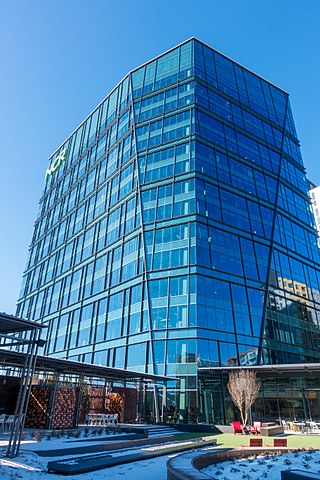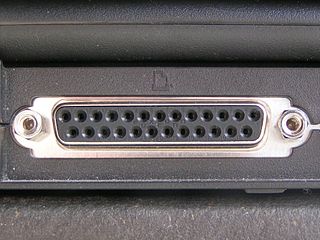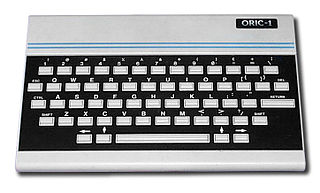Control Data Corporation (CDC) was a mainframe and supercomputer company that in the 1960s was one of the nine major U.S. computer companies, which group included IBM, the Burroughs Corporation, and the Digital Equipment Corporation (DEC), the NCR Corporation (NCR), General Electric, and Honeywell, RCA and UNIVAC. For most of the 1960s, the strength of CDC was the work of the electrical engineer Seymour Cray who developed a series of fast computers, then considered the fastest computing machines in the world; in the 1970s, Cray left the Control Data Corporation and founded Cray Research (CRI) to design and make supercomputers. In 1988, after much financial loss, the Control Data Corporation began withdrawing from making computers and sold the affiliated companies of CDC; in 1992, Cray established Control Data Systems, Inc. The remaining affiliate companies of CDC currently do business as the software company Ceridian.

NCR Voyix Corporation, previously known as NCR Corporation and National Cash Register, is an American software, consulting and technology company providing several professional services and electronic products. It manufactured self-service kiosks, point-of-sale terminals, automated teller machines, check processing systems, and barcode scanners.

In computing, a parallel port is a type of interface found on early computers for connecting peripherals. The name refers to the way the data is sent; parallel ports send multiple bits of data at once, as opposed to serial communication, in which bits are sent one at a time. To do this, parallel ports require multiple data lines in their cables and port connectors and tend to be larger than contemporary serial ports, which only require one data line.

UNIVAC was a line of electronic digital stored-program computers starting with the products of the Eckert–Mauchly Computer Corporation. Later the name was applied to a division of the Remington Rand company and successor organizations.
Centronics Data Computer Corporation was an American manufacturer of computer printers, now remembered primarily for the parallel interface that bears its name, the Centronics connector.

International Computers Limited (ICL) was a British computer hardware, computer software and computer services company that operated from 1968 until 2002. It was formed through a merger of International Computers and Tabulators (ICT), English Electric Computers (EEC) and Elliott Automation in 1968. The company's most successful product line was the ICL 2900 Series range of mainframe computers.

The PERQ, also referred to as the Three Rivers PERQ or ICL PERQ, is a pioneering workstation computer produced in the late 1970s through the early 1980s. It is the first commercially-produced personal workstation with a graphical user interface (GUI). The design of the PERQ was heavily influenced by the original workstation computer, the Xerox Alto, which was never commercially produced. The workstation was conceived by six former Carnegie Mellon University alumni and employees: Brian S. Rosen, James R. Teter, William H. Broadley, J. Stanley Kriz, Raj Reddy and Paul G. Newbury, who formed the startup Three Rivers Computer Corporation (3RCC) in 1974.
Apricot Computers was a British electronic company that produced desktop personal computers in the mid-1980s.
Pertec Computer Corporation (PCC), formerly Peripheral Equipment Corporation (PEC), was a computer company based in Chatsworth, California which originally designed and manufactured peripherals such as floppy drives, tape drives, instrumentation control and other hardware for computers.

Elliott Brothers (London) Ltd was an early computer company of the 1950s and 1960s in the United Kingdom. It traced its descent from a firm of instrument makers founded by William Elliott in London around 1804. The research laboratories were originally set up in 1946 at Borehamwood and the first Elliott 152 computer appeared in 1950.

MikroMikko was a Finnish line of microcomputers released by Nokia Corporation's computer division Nokia Data from 1981 through 1987. MikroMikko was Nokia Data's attempt to enter the business computer market. They were especially designed for good ergonomy.

CER model 12 was a third-generation digital computer developed by Mihajlo Pupin Institute (Serbia) in 1971 and intended for "business and statistical data processing". However, the manufacturer also stated, at the time, that having in mind its architecture and performance, it can also be used successfully in solving "wide array of scientific and technical issues". Computer CER-12 consisted of multiple modules connected via wire wrap and connectors.

The NCR 315 Data Processing System, released in January 1962 by NCR, is a second-generation computer. All printed circuit boards use resistor–transistor logic (RTL) to create the various logic elements. It uses 12-bit slab memory structure using magnetic-core memory. The instructions can use a memory slab as either two 6-bit alphanumeric characters or as three 4-bit BCD digits. Basic memory is 5000 "slabs" of handmade core memory, which is expandable to a maximum of 40,000 slabs in four refrigerator-size cabinets. The main processor includes three cabinets and a console section that houses the power supply, keyboard, output writer, and a panel with lights that indicate the current status of the program counter, registers, arithmetic accumulator, and system errors. Input/Output is by direct parallel connections to each type of peripheral through a two-cable bundle with 1-inch-thick cables. Some devices like magnetic tape and the CRAM are daisy-chained to allow multiple drives to be connected.

The NCR Century 100 was NCR's first all integrated circuit computer built in 1968. All logic gates were created by wire-wrapping NAND gates together to form flip-flops and other complex circuits. The console of the system had only 18 lights and switches and allowed entry of a boot routine, or changes to loaded programs or data in memory. A typewriter console was also available.
Atari 8-bit computer peripherals include floppy drives, printers, modems, and video game controllers for Atari's 8-bit computer family, which includes the 400/800, XL, XE, and XEGS.
Dataproducts Corporation was an early manufacturer of computer peripheral equipment.

Oric was the name used by UK-based Tangerine Computer Systems for a series of 6502A-based home computers sold in the 1980s, primarily in Europe.

The Singer System Ten was a small-business computer manufactured by the Singer Corporation. The System Ten, introduced in 1970, featured an early form of logical partitioning. The System Ten was a character-oriented computer, using 6-bit BCD characters and decimal arithmetic.
General Electric Specialty Control Plant is a 115 acres (47 ha) historic factory complex located in Waynesboro, Virginia. The complex includes three contributing buildings, one contributing site, and two contributing structures. The historic buildings and structures are a 340,000-square-foot main plant building, the original water tower, water tank, a group of evolved and interconnected construction sheds built from 1953 to the present, and an airplane hangar. The property, a former airport, was acquired by General Electric in 1953. The Waynesboro plant was one of some 120 individual operating departments created as part of a decentralization effort by the General Electric Corporation. The Specialty Control Plant was responsible for the development of breakthrough technologies in areas ranging from America's military efforts to space travel to computer technology. The facility was sold to GENICOM on October 21, 1983.

Mohawk Data Sciences Corporation (MDS) was an early computer hardware company, started by former Univac engineers in 1964; by 1985 they were struggling to sell off part of their company.













